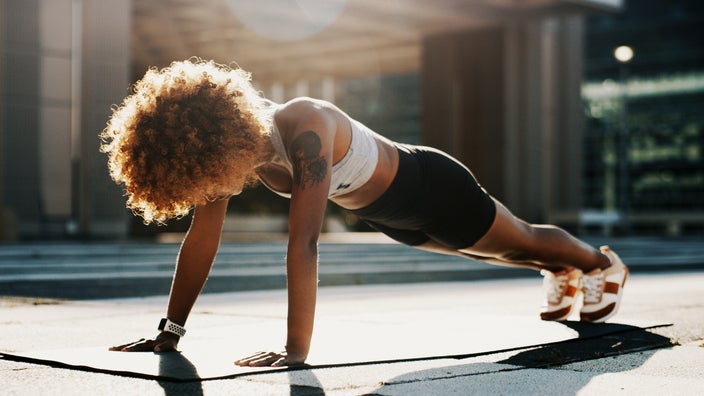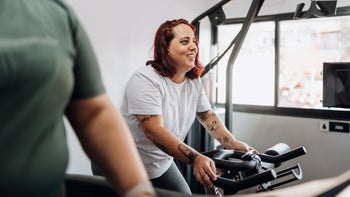
7 Science-Backed Benefits of Push-Ups and the Muscles They Work
Key takeaways:
Push-ups are a strength-building exercise that targets multiple muscle groups.
Doing this classic move two to three times per week can offer health benefits like a stronger core and better posture.
You can modify push-ups to make them more accessible and easier to do.
Table of contents

Push-ups are an equipment-free resistance exercise that can help you build muscle strength. And they’re not just for serious gym-goers. Whether you do traditional push-ups or a modified version, you can enjoy research-proven health benefits.
Here are seven reasons to consider adding this foundational exercise to your routine.
1. Push-ups work multiple muscle groups
It’s easy to think that push-ups are only good for your chest and arms. But this compound exercise engages multiple muscle groups at the same time. When done correctly, push-ups work your:
Chest (pectorals)
Shoulders (deltoids)
Arms (triceps and biceps)
Back (latissimus dorsi and erector spinae)
Stomach (abdominals)
Hips (gluteals)
Search and compare options
2. Push-ups increase upper-body strength
Push-ups are a great way to strengthen and tone your upper-body muscles, including your chest, triceps, and shoulders. You rely on these muscles for many activities, such as picking things up or pushing a shopping cart. Improving your upper-body strength can improve your functional fitness, making your daily tasks easier to do. And it might even boost your athletic performance.
3. Push-ups are good for your core
Your core should stay engaged during a push-up to keep your trunk stable and help you maintain proper form. This means that push-ups, which include a plank, can double as a core-strengthening exercise. According to a small study, advanced push-ups performed on unstable surfaces like an exercise ball are particularly effective for stabilizing your core.
While push-ups can strengthen your core, including your abdominals, they won’t give you defined abs on their own. For defined abs, combine regular workouts –– including targeted exercises like crunches –– with a balanced diet.
4. Push-ups can improve your posture
Core stability may also be good for your posture. By strengthening your back, shoulders, and abs, push-ups may help you improve your posture. That’s good news, as poor posture can lead to back pain, headaches, and impaired breathing. It may also be linked to low energy and muscle fatigue, which can hurt your exercise performance.
5. Push-ups support bone health
Bone mineral density is a key indicator of bone strength and overall health. The lower your bone density, the higher your risk of fractures and conditions like osteoporosis. Fortunately, weight-bearing and resistance exercises like push-ups, can help you build stronger bones.
6. Push-ups boost heart health
Heart disease is the leading cause of death among adults in the U.S. But regular exercise — including aerobics and strength training — reduces your risk. Perfecting your push-up form could be good for your heart, too.
Push-up vs. bench press: Find out which strengthening exercise is better.
Keep it equipment-free with calisthenics. This training method uses your body weight for resistance. Learn how to add calisthenics workouts to your routine.
Build total-body strength with push-pull workouts. Find out how they work and learn tips to get started.
One study points to a link between push-up capacity and heart health. Men who could do 40 push-ups had a significantly lower risk of heart problems over the next 10 years compared to those who could only do 10 push-ups or fewer. This finding isn’t surprising since strength training is known to promote heart health.
7. Push-ups are versatile and convenient
Many people associate strength training with weightlifting. But there’s more than one way to build muscle. Push-ups, for example, are a form of calisthenics — a strength-training method that uses your body weight for resistance. This makes push-ups a convenient, equipment-free exercise you can do anywhere. Plus, they’re a versatile move you can modify to make it more or less challenging based on your fitness level.
How do you do a push-up?
They might seem simple, but push-ups can be challenging. Taking your time and focusing on each step can help you master this strength-training move. Here’s how to do a traditional push-up.
Step 1: Start in a tabletop position on all fours, with your hands a little wider than shoulder-width apart.
Step 2: Step both legs back so that your hands and toes are the only things touching the floor. In this plank position, your feet should be hip-width apart.
Step 3: Engage your core by drawing your belly button up toward your spine. A tight core will help keep your body in a straight line from head to toe.
Step 4: Slowly bend your elbows to 90 degrees and lower yourself toward the floor. Keep your core engaged and your back straight.
Step 5: Push back up to the plank position by pressing through your hands.
Step 6: Repeat 10-15 times.
Read more like this
Explore these related articles, suggested for readers like you.
Tips for proper push-up form
As with any exercise, proper push-up form is critical. It can help you reap health benefits and avoid injury. Consider these tips as you practice push-ups:
Keep your core engaged during each push-up. This will prevent your back from arching and your hips from sagging.
Keep your head, neck, and shoulders aligned with your spine. Your gaze should be on the floor a few feet in front of you. Or you can look straight down while doing push-ups. If you can see the ceiling or your feet, your head is too high or low.
Keep your hands under your shoulders. Your hands should be just slightly wider than hip-width apart during a push-up. But they should still align with your shoulders. Placing them too far forward can put extra pressure on your shoulders.
Keep breathing. It’s tempting to hold your breath or breathe sporadically while performing challenging exercises. But it’s important to keep breathing to fuel your workouts. During each push-up, inhale as you lower your body and exhale as you push up.
What are some suggested push-up modifications?
Don’t worry if you can’t do a traditional push-up yet. Push-up modifications can help you perfect your form while still getting the benefits. Here are some options.
Wall push-up
Use a wall for support as you train your body to do a push-up correctly. This modification works the same muscle groups as a traditional push-up.
Step 1: Stand facing a wall with your arms outstretched, 3-4 inches wider than your shoulders. Rest your hands flat on the wall at shoulder height.
Step 2: With your body at a 45-degree angle, bend your elbows and lower yourself toward the wall. Push back against the wall until your elbows are straight.
Step 3: Repeat 10-15 times.
Diagonal push-up
The diagonal push-up uses a surface at about hip height, such as a kitchen counter. Be sure to use something stable. Avoid using tables or chairs.
Step 1: Stand at a kitchen counter and place your hands on the counter, slightly wider than shoulder-width apart.
Step 2: Step your feet back until you’re at a 45-degree angle. You should feel some of your body weight in your arms.
Step 3: Lower your body toward the counter. Keep your core engaged and your head aligned with your spine as you push back up.
Step 4: Repeat 10-15 times.
Half push-up
The half push-up is a great way to build the strength needed to do a traditional push-up. Once your muscles are strong enough, you can advance to a full push-up.
Step 1: Start on all fours, using an exercise mat for comfort.
Step 2: Walk your hands out until they’re just in front of your shoulders. Your hands should be about 3-4 inches wider than your shoulders, and your knees should stay on the floor.
Step 3: Drop your hips and engage your core to create a straight line from your head to your knees.
Step 4: Lower your body toward the floor until your elbows are at a 90-degree angle. Exhale and push back up.
Step 5: Repeat 10-15 times.
How many push-ups should you do a day?
There’s no magic number of push-ups you should do per day. Try working your way up to 1 to 3 sets of 10 to 20 repetitions to strengthen your upper body.
If building bigger chest muscles is your goal, doing more push-ups might seem ideal. This bodyweight exercise can increase muscle mass in your pectorals, making them more visible. But there are downsides to doing too many push-ups too often. For example, it can lead to pain in your wrists, elbows, and lower back. You can prevent pain in these areas by focusing on proper form.
Overtraining your chest can also cause muscle imbalances or injuries. To avoid an imbalance, work opposing muscle groups –– such as your rhomboids, trapezius, and rear deltoids –– in your back and shoulders. Pair push-ups with reverse fly or inverted row exercises. You can also set aside certain days of the week to practice push-ups and other days to stretch your chest muscles.
Is it OK to do push-ups every day?
Popular fitness challenges encourage doing push-ups every day. But making time for rest and recovery is essential to a well-rounded fitness routine. The goal is to challenge yourself without overdoing it. Otherwise, you’ll risk injury or overexertion — a common workout mistake.
Research suggests a 48- to 72-hour rest period is adequate recovery for resistance training. So, it might be better to do push-ups every 2 to 3 days instead of daily. On rest days, you can practice active recovery with low-impact exercises like walking or swimming. Just be sure to listen to your body and give yourself a break when necessary.
Frequently asked questions
Doing 100 push-ups a day can help build muscle mass, strength, and endurance, especially in your core and upper body. But it can also increase your risk of muscle imbalances, injury, and overtraining. It’s important to focus on proper form when practicing push-ups. Gradually increase your reps and sets as your fitness improves.
To avoid overdoing it, include other exercises, different types of workouts, and rest days in your weekly routine.
No, push-ups don’t burn belly fat. In fact, research suggests that you can’t target fat loss in one specific body part. But push-ups can help burn calories and build or strengthen muscles, which can contribute to overall fat loss. To manage your weight in a healthy, sustainable way, incorporate healthy habits like:
Performing regular cardio and strength-training workouts
Eating a balanced diet
Getting adequate, restful sleep
Practicing stress management techniques, like meditation and deep breathing
While there are many benefits of push-ups, this exercise also has disadvantages. For example, push-ups can lead to:
Injuries, such as shoulder, wrist, or elbow strain, particularly when done with improper form or when overdone
Muscle imbalances, especially if you don’t do exercises that target other muscle groups
A fitness plateau, which occurs when you stop seeing progress in your routine
Yes, push-ups and other resistance exercises may increase testosterone levels. But the effect is temporary and can depend on factors like your fitness level, exercise intensity, and duration of the specific exercise.
The bottom line
There are plenty of reasons to add push-ups to your fitness plan. This equipment-free exercise can be done anywhere and offers benefits like stronger muscles and better posture. Modifications, including the half push-up, make this exercise accessible to many, from fitness beginners to pros. Don’t forget to give your muscles time to rest and recover to get the best results.
Why trust our experts?



References
American Council on Exercise. (n.d.). Kneeling reverse fly.
Anderson, G. S., et al. (2011). Comparison of EMG activity during stable and unstable push-up protocols. European Journal of Sport Science.
Azeem, K. (2015). The push-up. International Journal of Fitness, Health, Physical Education & Iron Games.
Bone Health & Osteoporosis Foundation. (n.d.). Low bone density.
Centers for Disease Control and Prevention. (2024). Heart disease facts.
Contreras, B., et al. (2012). The biomechanics of the push-up: Implications for resistance training programs. Strength and Conditioning Journal.
Finlay, M. J., et al. (2021). Upper-body post-activation performance enhancement for athletic performance: A systematic review with meta-analysis and recommendations for future research. Sports Medicine.
Hong, A. R., et al. (2018). Effects of resistance exercise on bone health. Endocrinology and Metabolism.
Hooper, D. R., et al. (2017). Endocrinological roles for testosterone in resistance exercise responses and adaptations. Sports Medicine.
Howcast. (2012). How to do a push-up properly | Gym workout [video]. YouTube.
Kikuchi, N., et al. (2017). Low-load bench press and push-up induce similar muscle hypertrophy and strength gain. Journal of Exercise Science and Fitness.
Lu, L., et al. (2020). Effective assessments of a short-duration poor posture on upper limb muscle fatigue before physical exercise. Frontiers in Physiology.
MedlinePlus. (2024). Bone density.
Monteiro, E. R., et al. (2019). Effects of different between test rest intervals in reproducibility of the 10-repetition maximum load test: A pilot study with recreationally resistance trained men. International Journal of Exercise Science.
National Academy of Sports Medicine (NASM). (2021). How to do a push-up | Proper form & technique | NASM [video]. YouTube.
Pluta, R. M., et al. (2011). Tension-type headache. JAMA.
Thielen, S. (2023). 5 chest stretch variations. American Council on Exercise.
Thomas, E., et al. (2017). The effects of a calisthenics training intervention on posture, strength and body composition. Isokinetics and Exercise Science.
Yang, J., et al. (2019). Association between push-up exercise capacity and future cardiovascular events among active adult men. JAMA Network Open.



























